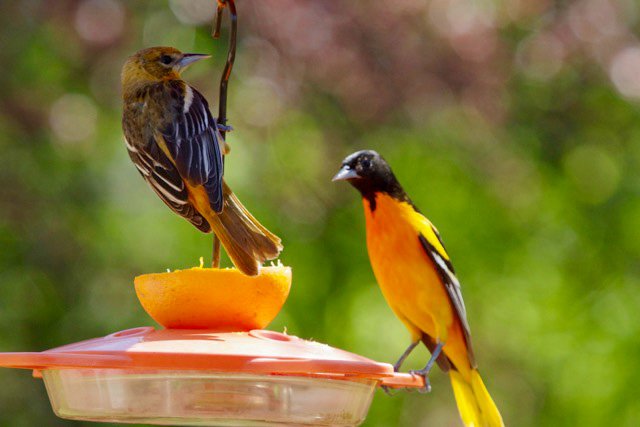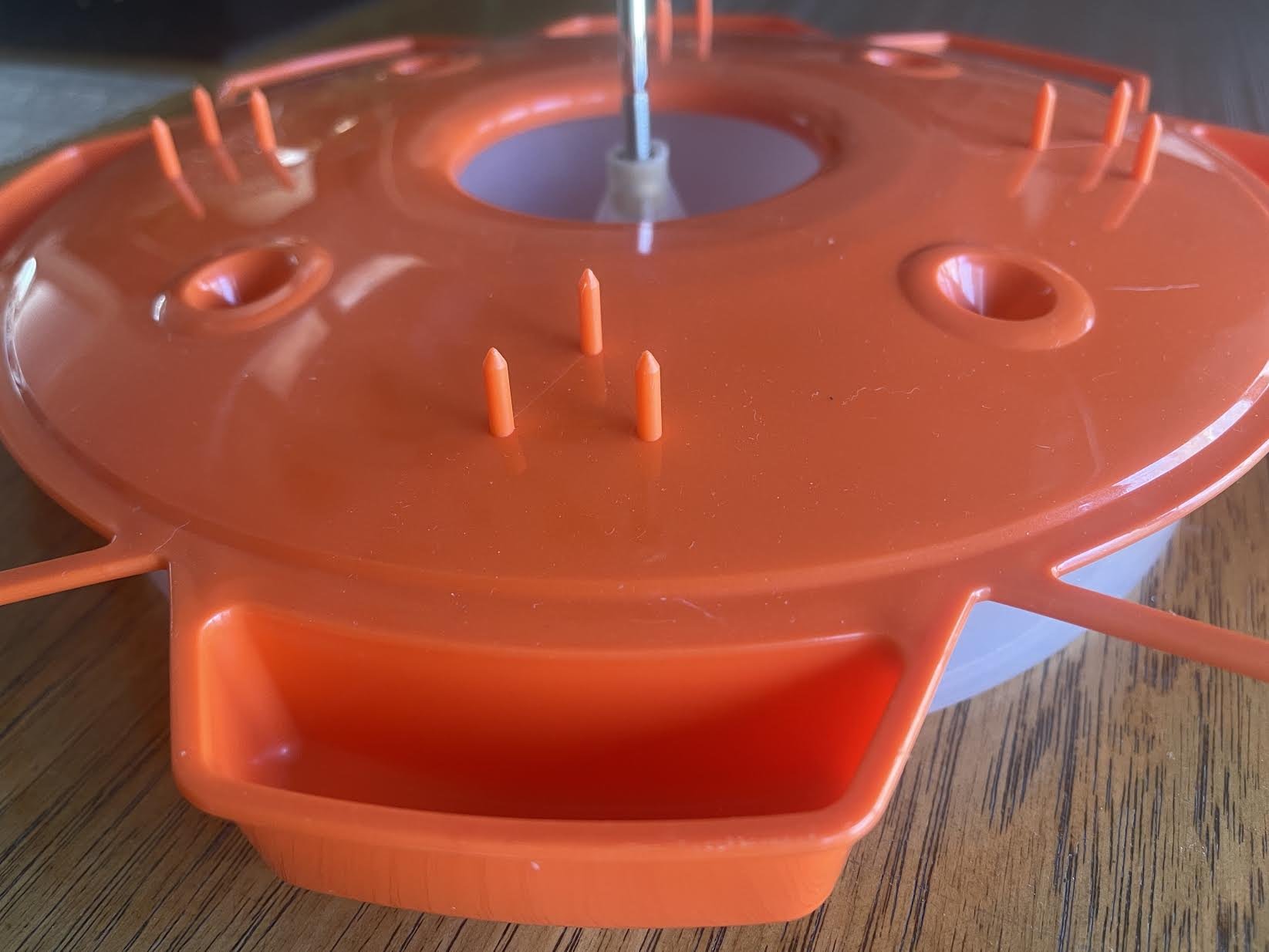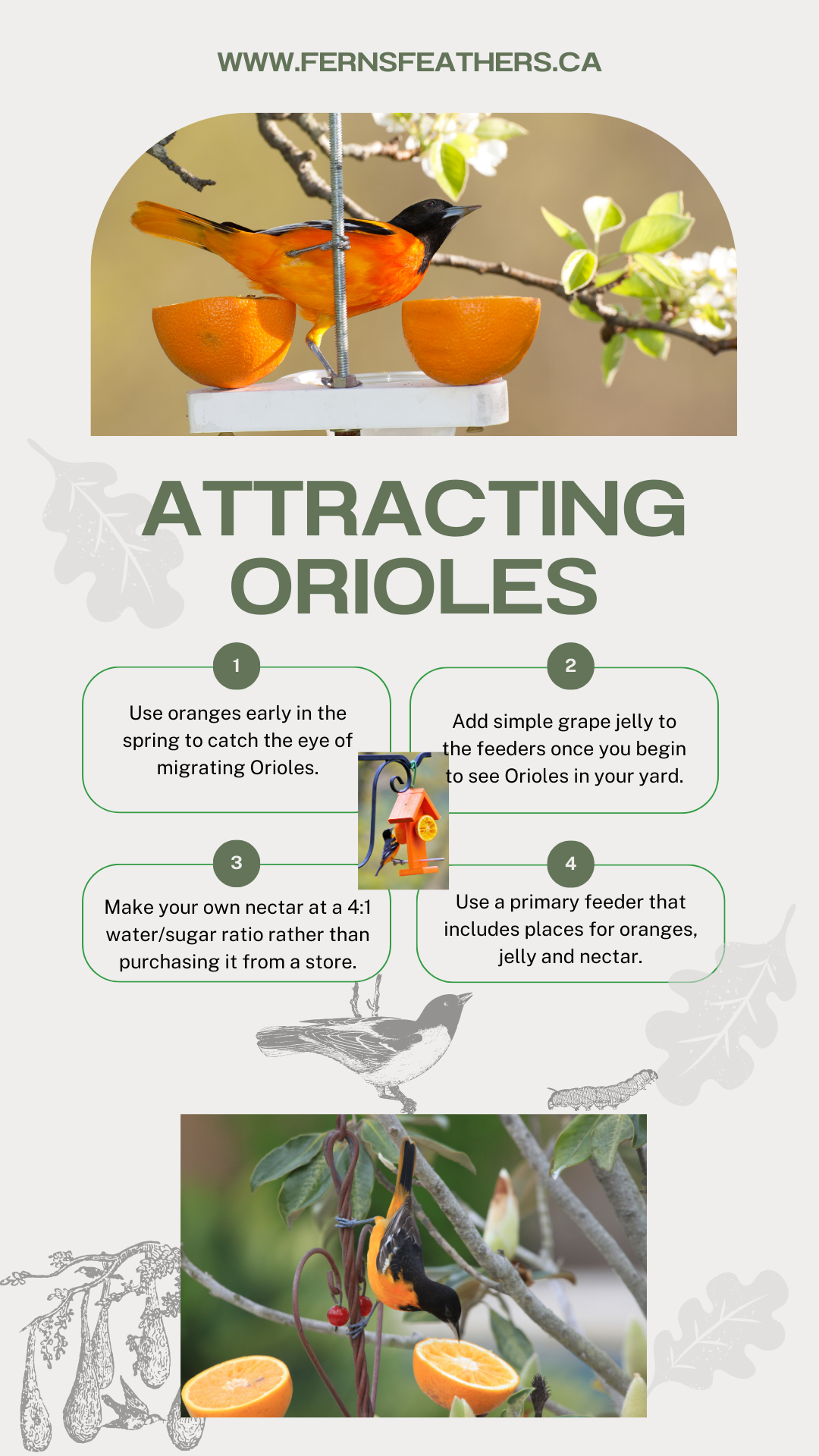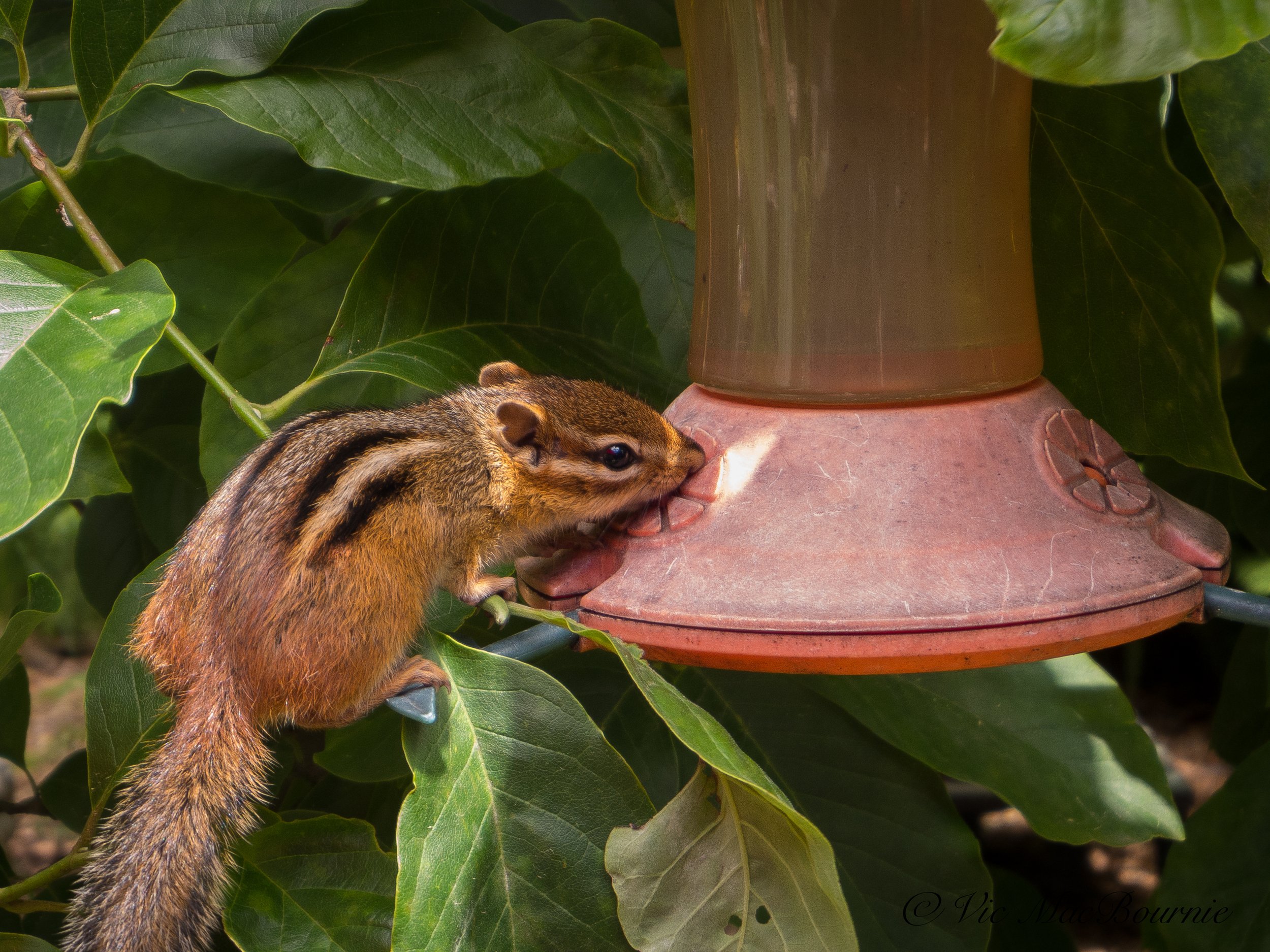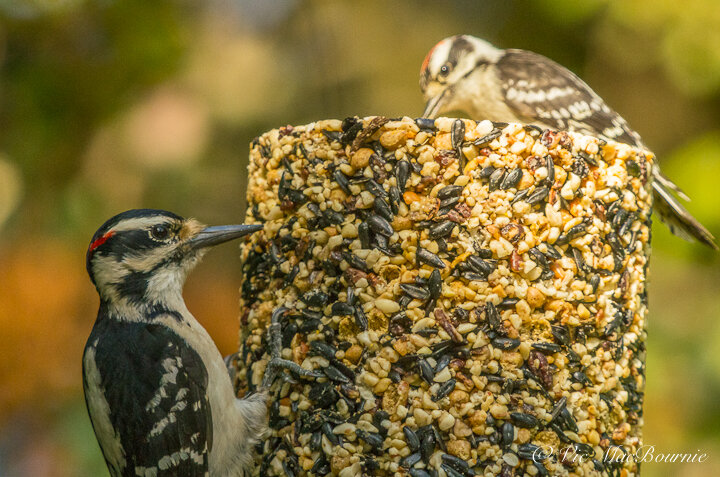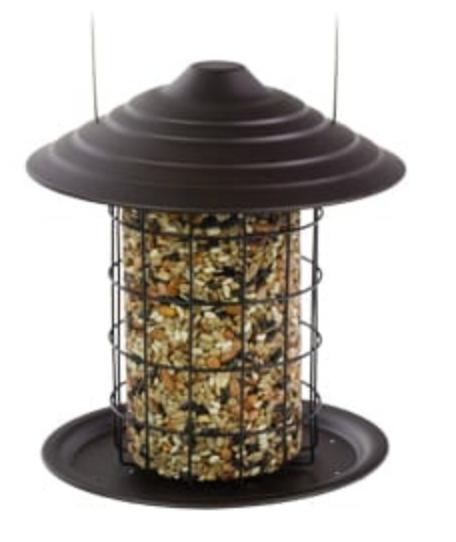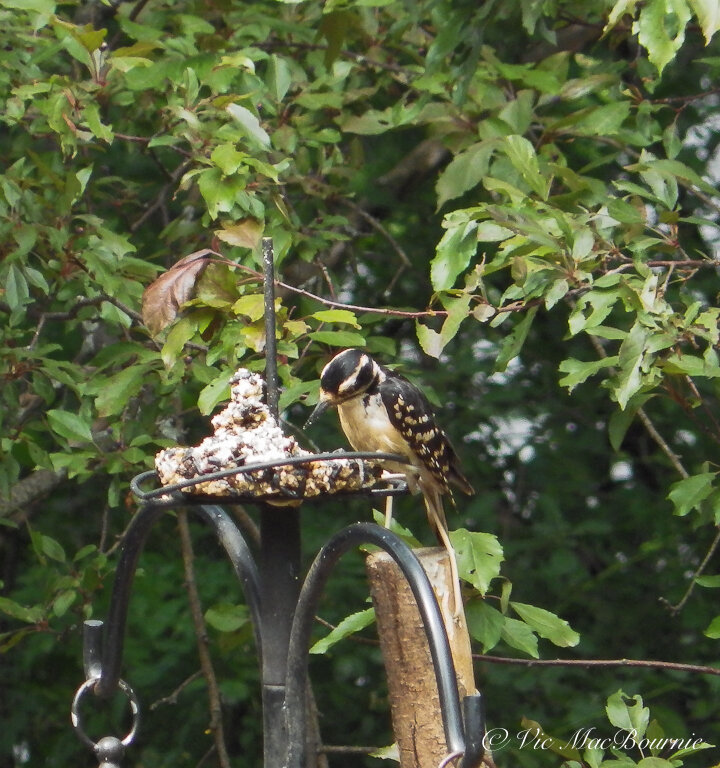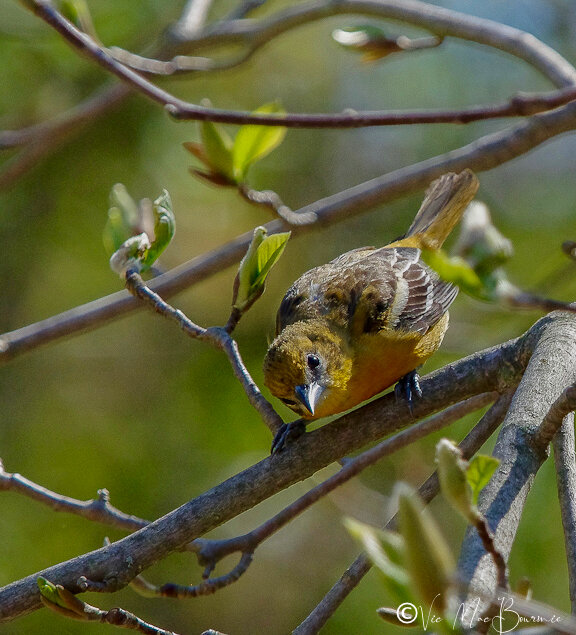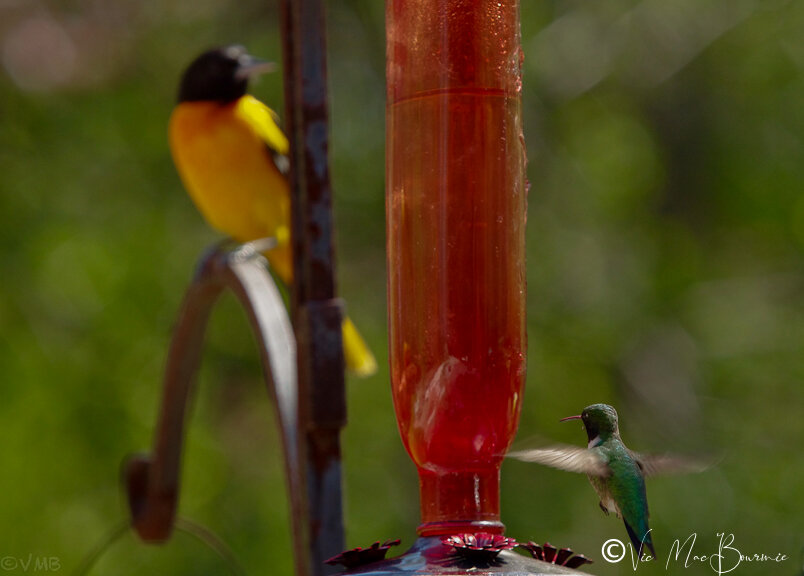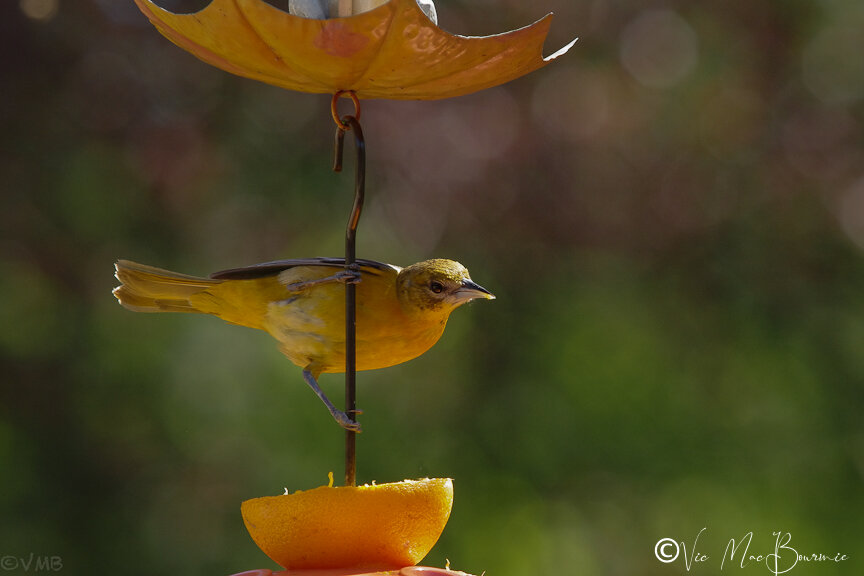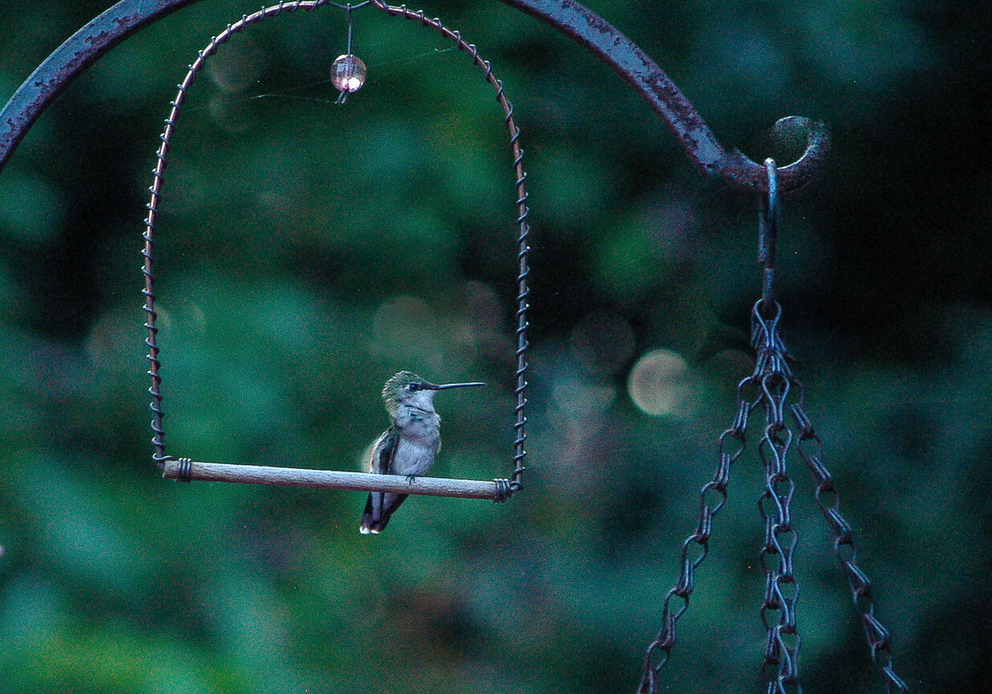Best Oriole bird feeders
Attracting orioles to your yard starts with having a high quality feeder that includes the ability to feed nectar, oranges and grape jelly.
Look for a high quality all-in-one feeder
Attracting Orioles to your backyard starts with giving these colourful birds a proper feeder that provides them with a variety of their favourite foods, including oranges, grape jelly and, of course, sugar water or nectar.
The best feeders provide areas for all three food sources, but there may be reasons to provide feeders that focus on one or two of the food sources at different times of the year.
In our yard, I use a number of different feeders – ranging from a simple nectar feeder similar to a hummingbird feeder, to DIY Jelly feeders and orange-half holders, to commercially bought Oriole feeders that hold nectar and a half orange to one that holds all three.
If you are buying a new feeder, I would probably aim for a feeder that holds all three – nectar, oranges and grape jelly.
However, this page of Oriole feeders from Amazon is a clear indication of how many styles of feeders are available.
These oriole feeders from Etsy show how many varieties are available and how easy some styles are to create as a DIY project.
These Oriole feeders from Maine-based Gardener’s supply are good choices as are these high quality Oriole feeders from the Canadian and American based Wild Birds Unlimited.
Where to locate oriole feeders
However, a feeder that provides all three of these foods might not necessarily prove to be very successful at attracting or encouraging the birds to return to the yard. Where the feeder is located in the yard, and how accessible it is to the birds can play an important role in the success of attracting orioles and keeping them coming back to your yard.
When you first put up the feeder, make sure that birds flying over head can see it. Tucking it away in a tree might seem like a great idea, but many of the migrating orioles will likely miss it and fly on by.
Hanging the feeder from a hook out in plain site is a good idea. You can hang it on your main bird feeding station, but Orioles generally prefer a quieter area, so finding a spot away from the busiest area of the garden is preferred.
More on attracting Orioles to your yard, on my earlier comprehensive post.
Once the birds find the feeder(s) however, I have found that they feel comfortable feeding with other birds around them. At this point, I might put up a feeder or start feeding oranges on my main feeding station in addition to the original feeder location.
I have had as many as 12 Orioles see image above) on our main feeding station working oranges, and grape jelly among the seed-eating birds like Blue Jays and Cardinals. The stylized steel branch is the perfect spot to hang additional feeders and the wire leaves is a perfect spot to stuff orange halves into for the Orioles.
Keeping them around and where do Orioles nest?
Orioles can be a little picky when it comes to setting up their summer homes. Remember, these are nest-dwelling birds that do not use bird houses or tree cavities. They create hanging nests fairly high in trees where they are safe from most predators. We had a pair nesting in a mature maple in our front yard one year. If you do not have tall trees nearby, you might have some difficulties keeping the birds around all summer.
Insects are key to keeping Orioles all summer
It’s also important to remember that orioles are primarily insect-eating birds. They are attracted to your yard with the oranges and grape jelly as a quick energy hit after a long migration, but will only stick around if there is an abundance of insects to feed their young.
With that in mind, you might also want to set out a dish of meal worms near their feeder to attract them and keep them around longer.
Your best chance to attract Orioles is spring migration
But that’s not to say that you can’t attract them to your yard during spring migration with orange halves, nectar and jelly.
If the feeding stations fail to provide the Orioles with what they need, they will often simply stop off for a quick meal and move on. And that’s okay too. Having these bright colourful birds around for just a few days in spring is still a joy.
That stay could just be for a few minutes to an afternoon or even a couple of days, but many of the birds will eventually move on.
If they do move on, don’t take it personally. It may not mean your feeding setup was not to their liking, but that their nesting site is traditionally farther north in their annual migration.
The key is to make your yard so enticing, that first-time nesting pairs and others choose your yard to set up their homes.
Oranges are your first line of enticement
In my years of attracting Baltimore Orioles to our garden, I have found that oranges are the best first impression to provide the birds to encourage them to your yard. After spending the winter in Florida and other warm climates where oranges are common food sources, it’s understandable why Orioles would recognize the orange halves at our feeders.
My first feeder did not come with a specific holder for an orange half. Instead, I simply insert the orange half over the steel rod that the feeder hangs from. This allows the Orioles to grip the rod and feed at the same time. Changing the orange halves to keep a fresh supply is easily done.
Many of the new feeders have spikes where the orange halves can be positioned. If you are buying a new feeder, make sure it has a location to display either orange halves, or orange quarters.
Don’t forget to stock up on grape jelly
If oranges are what attracts the Orioles to your yard, it’s grape jelly that keeps them coming back.
Our Orioles just love their grape jelly mixed with a little water. Our newest feeder even has three small reservoirs that are perfect locations to add a spoonful of grape jelly.
In the past, I created my own DIY grape jelly containers out of orange plastic caps from a food container that I hung near the main nectar feeders.
I soon realized, however, that the spent orange halves were also good containers to fill with grape jelly once the Orioles had finished with the oranges. The pulp in the oranges however, does absorb the jelly water making the halves short lived as an ideal feeder.
A small glass dish filled with grape jelly mixed in a little water is a favourite for our Orioles and it is easy to clean an refill on a daily basis.
One of our resident chipmunks took a liking to the nectar in the Oriole feeder this past summer.
Nectar is good for a burst of high-energy
One of the first feeders I purchased was a nectar feeder that looked like an orange-coloured hummingbird feeder. It has never performed that well for us in attracting Orioles, but one of our resident chipmunks sure took a liking to it last year. Everyday, the chipmunk would come and get its hit of sugar water from the feeder.
It enjoyed the nectar so much that it wouldn’t stop drinking no matter how close I got to it to get a picture.
Oriole nectar should be mixed the same as hummingbird nectar. Do not buy the store-bought nectar packages with the orange food colouring. Just mix 1 part sugar with 4 parts of water to create the nectar. I like to boil the water before using it to clear out any impurities in the water. I also find it stays clear longer if it is boiled.
There are lots of high quality Oriole nectar feeders that are available. This plastic feeder from Home Hardware is an excellent choice. Don’t be surprised if it also attracts hummingbirds.
Best Oriole feeder conclusion
There are so many high quality Oriole feeders available today that it is difficult to recommend one brand or style. In fact, if you are like me you probably have Orioles visiting your hummingbird feeders more than your actual Oriole nectar feeders. I believe that this is because the Orioles are more accustomed to seeing the red hummingbird feeders and know there is a treat waiting for them inside.
The fact that Orioles are attracted to our DIY feeders as they are the commercial varieties also says a lot about how picky they are or are not when it comes to their favourite food.
But providing them with oranges, jelly and nectar in one convenient spot is your best chance at making a first impression with these wonderful birds. If a combination feeder can get their attention, you can use more dedicated style feeders to keep them coming back.
There are feeders that take an entire jar of grape jelly that some have reported are excellent magnets for the orioles. I can’t help but think these also attract their share of bees and wasps to the sugary jelly. They may even get moldy if the jelly is not eaten quickly enough.
I have also seen beautiful handmade Oriole feeders available on Etsy that would make a lovely addition to your garden. Most of these are excellent secondary feeders that could be added once you have success attracting and keeping the orioles around all summer.
One last thing to remember, Orioles enjoy a dependable source of water as well. Don’t forget to ensure water is available.
One of my favourite series of images I was able to capture was a female Oriole bringing her entire brood of babies down to our on-ground bird bath for most likely their first bath. That was a frenzy of excitement for both the birds and the photographer (image above) and a reminder of why it’s worth the effort to attract these beautiful birds to your yard.
Seed cylinders: One of the best feeders for backyard birds
Seed cylinders are an excellent way to feed backyard birds. The cylinders keep the birds at your feeder longer and can be changed depending on the season and the type of birds you are trying to attract.
Woodpeckers, nuthatches, cardinals love compressed seed cylinders
When it comes to feeding backyard birds, there really isn’t a better combination than a compressed seed cyclinder fitted to your feeding station.
I have had my “ simple spike” on my Wild Birds Unlimited Advanced Pole bird feeding station for several years and am so impressed with it that I consider it (and most of the birds agree) my primary feeding source for our backyard birds.
Why are seed cylinders so popular?
Seed cylinders not only bring in a large variety of birds, they keep them at the feeder longer so you can appreciate them more, and a single large cylinder can last for weeks compared to the equivalent amount of feed in a typical hopper-style feeder. They are also super convenient to use and are available in a variety of seed combinations meant to attract different birds at different times of year.
These seed cylinder feeders (pictured above -click on picture to take you to their website) are from U.S.-based Best Nest and are an excellent way to offer the birds a variety of compressed seed to choose from. The roofs are especially helpful to keep the feed from spoiling after a rain. Best Nest is a family-owned on-line store that also offers an excellent assortment of loose bird feed, as well as bird houses and feeders. Best Nest is a family owned on-line retailer based out of Cincinnati Ohio.
Seed cylinders are long-lasting, which makes them especially useful if filling feeders is difficult for you or you’re going on vacation and will be unable to fill your feeders for several days. The cylinders are especially great summer food for the woodpeckers during the heat of the summer when traditional suet feeding can be a challenge.
Blue Jays are also big fans of the compressed seed cylinders as well. Click on the link for more on two of my favourite Blue Jay feeders including the compressed seed cylinder.
The cylinders help to keep birds at the feeders longer because they have to work at the seeds to remove them from the cyclinders. At a traditional feeder, the birds often swooping in, grab a bite and take off, before you can even appreciate them. Seed cylinders can give you a few extra moments of enjoyment.
Our cylinder feeder attracts a host of birds including plenty of woodpeckers who enjoy hammering away at the cylinder to obtain their dinner.
Five Great reasons to use seed cylinders
Seed cylinders are convenient to use. They do away with bulky bags of seed and the waste that can occur when trying to load loose seed into feeders.
They keep birds at the feeder longer so that you can get a better look at the birds. They are especially useful to get good looks at more rare birds who visit such as Indigo buntings and woodpeckers.
Seed cylinders are available in several combinations aimed at different seasons and bird-feeding mixtures.
No-melt seed cylinders provide an excellent way to attract woodpeckers during warmer months when suet is not appropriate.
The feeders and seed cylinders are available in many sizes, including pucks where you can offer a variety of seed mixes at a single feeder.
The Advanced Pole system loaded with various feeders, including the seed cylinder at the top of the pole.
I purchased my cylinder spike probably ten years or more ago as a simple, inexpensive solution to replace an aging wooden open feeder.
I was looking to replace my homemade feeder with another similar open hopper-style feeder, but noticed the variety of seed cylinders available with the spike system. At the time there were far fewer choices than there are today, but still enough to convince me to move away from another hopper-style feeder.
Since then, many manufacturers have developed a number of newer feeders designed to work with their seed cylinders. (Here is a link to their assortment of cylinder feeders).
One of the drawbacks to my spike is that it does not provide any protection for the seed cyclinder from rain and snow.
As a result, the cyclinder can break down prematurely during periods of heavy rain and humidity. Although the birds may appreciate the ease at getting at the seed during these times, I prefer to make them work a little for their dinner.
Today’s cylinder designs solve the problem of an unprotected cylinder open to the elements. Most have a roofing system of some kind built into them to provide top-down protection to the seed cylinders and reduce the amount of premature break down.
I’m not sure our blue jays and woodpeckers would be happy if a roof covered their favourite feeder. They mostly just stand on the seed cylinder and pound away at it from the top.
The result, of course, is that the birds’ hard work further breaks down the top of the cylinder and opens it up to the elements.
Wild Birds Unlimited feeder complete with a cage to prevent large birds from dominating the feeder.
The new designs not only provide a roof for seed protection, several have cages to keep the larger birds from dominating the seed cylinders and giving our smaller birds a better opportunity to enjoy the benefits the seed cylinders offer.
There is no doubt that the larger backyard birds, including blue jays, woodpeckers, cardinals, grackles and even crows, descend on our cylinders and dominate them at times.
I’ll take advantage of any opportunity to restrict their access to the cylinders.
WBU’s globe cylinder feeder’s cage is large enough to accommodate mid-sized birds like indigo buntings, sparrows, nuthatches and downy woodpeckers just to name a few. The feeder handles the regular-sized cylinders which include the no-melt cyclinders. The cage also acts as perches for the birds.
And, if the pesky squirrels manage to get up to your feeder, the cage represents another barrier to protect your expensive seed.
WBU’s Tidy feeder combines the best of all worlds with a built-in roof, a cage and a base to catch any fallen seed.
The Tidy Cylinder feeder is a great choice providing not only a roof to protect the seed from the elements and a cage to protect the seed from larger, more aggressive birds, it also includes a small, built-in catch tray to keep the seed from falling to the ground.
Other modern feeders provide open access to the cylinders, but add several perching areas to provide more access for smaller birds to enjoy their meal in peace.
A mostly eaten seed cylinder shows how the spike attaches to the pole and how the seed cylinder fits over the simple spike.
How the spike system works
Setting up my cylinder spike on the Wild Bird Advanced Pole system was simple. One of the benefits of investing in a system allows you to easily add various options.
The spike feeder simply inserts into the top of the pole system. Once attached, the seed cylinder (which comes with a hole drilled through the middle of it) is inserted over the spike. My feeder has a circular perch at the base that surrounds the cylinder, but most of the visitors simply jump on the cylinder and begin helping themselves.
Many of the new cylinder feeders are meant to hang from hooks rather than be inserted directly in the pole. This provides more opportunities to use them on any pole system or hung directly in trees.
How are the seed cylinders made
Seed cylinders are a compressed mixture of seed, nuts, and/or fruit and, depending on the mix, insects such as meal worms can be added. The feed is compressed into cylinders and mixed with Gelatin to hold the seed mixtures together.
Then it is cut to size and ready for use.
If you are on a budget or just looking to save some money, making your own cylinders is easy enough. There are several step-by-step “DIY” projects available on both Google and YouTube that will guide you through the process.
While I get great enjoyment from my bird feeding stations, providing natural food sources to our feathered friends is always the goal we should aspire to in our gardens. I have written a comprehensive post on feeding birds naturally. You can read about it here.
Bird feeding station ideas (Five of the best feeders)
A centralized bird feeding station is a great way to focus birds’ attention on your feeders and to discourage squirrels and other mammals from stealing all your food. Here are five great options to add to your bird-feeding pole to make it even more enticing for backyard birds.
Advanced Pole System offers bird feeding solutions
If you are serious about birds, purchasing or building a comprehensive bird feeding station is likely one of the best decisions and investments you’ll make.
Twenty years ago, I would never have thought our single pole bird feeding station would continue to be the central focus of our bird feeding station today.
But it continues to perform as well, if not better, than it did the day I purchased it.
A high quality, comprehensive bird feeding station not only helps to focus the feeding in a specific area of your garden where you can watch the birds, it allows you to customize it with optional feeders to attract a greater variety of birds and easily adapt the feeders to seasonal needs.
While I get great enjoyment from my bird feeding stations, providing natural food sources to our feathered friends is always the goal we should aspire to in our gardens. I have written a comprehensive post on feeding birds naturally. You can read about it here. If you are looking for high quality bird feeders, consider spending a little more and purchasing recycled resin feeders like the ones in the photo below. Be sure to check out my post on why resin feeders are better than wood.
The pole system I use, for example, changes throughout the year depending on what I am feeding. Smaller optional feeders that easily attach to the main pole are used at different times of the year to provide fruit, while others are ideal for offering meal worms, peanuts or jelly for orioles.
Other optional accessories provide different landing and perching spots for the birds as well as add-on trays to catch seed and provide an area for larger birds to feed.
There are many systems available that offer an array of options, but one of the most comprehensive and customizable systems is the Advanced Pole System from Wild Birds Unlimited. (Check out WBU on-line brochure of the entire system)
If you are not familiar with the franchise, it offers brick and mortar stores throughout Canada and the United States as well as a comprehensive on-line store.
Another, simpler, but convenient and high quality pole is available through Gardener’s Supply Company on-line store. It is particularly adaptable for decks or other locations where you may want a feeder close to a window.
This pole system from Best Nest (click on the image to take you to their on-line site) is simple. Ground sleeve keeps item stable in soil. The top bracket attaches to the base or back of the bird house. The unit is made in the USA.
Gardener’s Supply describes it as a kit that includes five 16-inch sections of 1-inch diameter pole. you can use as many sections as you like for the desired height. The kit also includes two adapters that allow you to mount a wooden or metal item at least 3-inches square on the bottom. Black, powder-coated steel pole is unobtrusive, letting your feeder or birdhouse take center stage.
Gardener’s Supply also offers some of the finest bird feeders you could find to hang from the pole system. The company’s on-line store has a complete offering of bird feeders that are certainly worth checking out here.
I purchased our bird feeding station pole from a local Wild Bird Unlimited store at least 20 years ago and it has performed exceptionally well since then. Even after several moves around the garden, it continues to stand up to the rigours of a host of heavy, seed-laden feeders, birds, squirrels and difficult Canadian winters.
To see the pole in action, check out my earlier post on attracting blue Jays and my article on my two favourite Blue Jay feeders. And, be sure to check out my post on why seed cylinders are a must for any feeding station.
Five of the best optional bird feeders for your pole system
1) The Spike: By far my favourite option is a simple spike that fits on top of the feeder pole to hold compressed seed cylinders. The seed cylinders are woodpecker magnets but they also attract Blue Jays, nuthatches, chickadees and cardinals just to name of few. The key to the cylinders is that they not only attract the birds, the birds stay longer because they have to work at removing the seeds from the cylinder.
2) Catch Tray Feeder: WBU offers a catch tray that attaches directly to the pole and catches much of the feed that is cast aside by birds that are more interested in their prized sunflower seed. The tray is perfect for feeding larger birds by offering shelled peanuts and other larger snacks to our feathered friends.
3) Suet cage: The built-in suet cage that attaches directly to the WBU pole is just a simple way to offer suet or compressed seed cakes to the smaller birds throughout the year. Although I also use a separate WBU suet feeder complete with a tail feather prop for larger woodpeckers, the pole mounted cage offers convenience and is used to provide nesting material to birds in the spring. Spent grasses, and other goodies are stuffed into the cage for the visiting birds to take with them after their snacks.
4) Half ball: For special treats, including oranges in the spring and suet balls in winter, WBU offer optional, clip-on, steel half balls that are perfect for holding dried fruit and other smaller offerings including a handful of meal worms. They are available in basic black and orange to attract orioles.
5) Covered plastic dishes: The plastic, removable dishes are ideal for offering special treats that benefit from being somewhat sheltered from the elements. The roof is separate and can be adjusted to suit the heights of the birds you expect to be attracting or to ensure the food is properly covered. Fresh berries and meal worms are perfect offerings for these small dishes. Because they are easily removed from the steel carrier, they can be brought in the house for a quick cleaning.
Give birds a place to land near your feeders
There are two excellent accessories that I consider almost essential to my Advanced pole system.
The first is the Decorative Branch Perch that serves not only as an additional source to hang various feeders, but more importantly a comfortable perch for birds to land on before moving in on the feeders. The perch fits directly on the Advanced Pole and allows easy positioning 360-degrees around the pole.
The wire “leafs” are the ideal spot to squeeze in large orange halves for orioles or hang smaller feeders.
One of my favourite options on the pole system is a simple, small, open cylinder that fits on the pole and provides a holder for a good-sized natural tree branch. The option is perfect for photographers looking to capture natural images of birds at the feeder. The ability to position the branch anywhere in the 360-degree circle around the feeders is perfect for taking advantage of different lighting situations and backgrounds.
It’s also super easy to swap out different branches so that not all of the bird photographs contain the same branch images.
Why use a pole system to feed birds?
A key benefit to using a single pole system as your primary feeding station for birds is the ability to keep unwanted visitors from eating all your seed. Squirrel and raccoon baffles are a must to keep the critters from getting up and feasting on your expensive feed and potentially destroying expensive feeders.
With the single pole system, you can focus all your efforts on deterring the squirrels and other mammals rather than fighting to keep them away from various parts of the garden with expensive feeders designed to spin-off squirrels or close down feeding opportunities for our non-feathered friends.
Placing the pole system in an inaccessible spot is vital to success. Keep the pole system about 10 feet away from trees and other structures (including your home or a shed) where squirrels can jump aboard.
Depending on the athletic ability of your backyard squirrels, you may have to move the pole even farther away. I have an Olympic-calibre black male squirrel that can jump vertically higher than most of my baffles. I’m hoping all the high-quality seed he is feasting on will eventually cause him to get too fat to continue these medal-winning high jumps.
There is no doubt that a concentrated feeding area can bring in unwanted visitors to your feeders, including mice and rats. There are important steps you can take to keep these unwanted visitors from your yard. Be sure to check out my comprehensive post on Keeping Rats and Mice out of your yard.
Check out my best birding buys article for more on bird-feeding poles and other optional feeders
• As an affiliate marketer with Amazon or other marketing companies, I earn money from qualifying purchases.
How to attract Orioles with oranges, jelly and insects
There is something exciting about looking out the window in May and seeing a flash of bright orange in the early spring. It’s a sure sign that the Orioles are back. And it’s not too late to get the Oriole feeders set up, the oranges cut up and the Jelly mixtures in place for the flush of Orioles.
Go natural: Provide insects and berries for Orioles
I’m sitting in my home office in the middle of May with a light dusting of snow on the ground watching Baltimore Orioles working one of the orange halves I left out on the feeder for them
Last year, I remember as many as seven swarming the feeder. They were feasting on oranges and nectar from a commercial feeder that I had put out for them to catch their attention as they migrated back to their more northern summer breeding grounds here in Canada, from winters in Mexico, Central and South America.
If you want to attract Orioles and keep them around year round, you’ll have to make sure your Woodland provides them with everything they need so they decide to call it home. That includes an upper tree canopy where they often build their nests.
While I get great enjoyment from my bird feeding stations, providing natural food sources to our feathered friends is always the goal we should aspire to in our gardens. I have written a comprehensive post on feeding birds naturally. You can read about it here.
Orioles live in open woodlands particularly those with deciduous trees and lots of insects.
Oranges will go a long way to entice Orioles to visit your yard in spring, but grape jelly, nectar (in the same 4 to 1 ratio of water and sugar used to attract hummingbirds) provided in commercial feeders and berries in your garden from native trees and shrubs will help to convince the birds to stay around all summer. Don’t forget to provide an abundance of insects, including meal worms, which is the main food of Orioles when feeding their nestlings and throughout the remainder of the summer.
A male oriole works an orange half on the top of an Oriole feeder filled with the same sugar water mixture used for hummingbird feeders.
Here in Southern Ontario and Eastern United States we are limited to the Baltimore and orchard orioles. There are actually nine orioles throughout the United States, but only five are common.
The Bullock’s is found throughout Western Canada and the United States.
Once you’ve got them, and providing you give them the requirements they need, they often return year after year to raise their young.
More on what are the best Oriole feeders here.
Spring migration troubles 2021
Of Note: In the spring of 2021 many homeowners who normally have had Baltimore Orioles in their gardens are reporting that the birds either did not show up or appeared for only a day or two and moved on never to be seen again. I usually have a large number of orioles in the garden throughout the summer raising their young. This year, although a few passed through, none stayed around for more than a day or two. I have seen similar reports of decreases in Baltimore Oriole numbers throughout southern Ontario into northeastern U.S.
There appears to be no obvious reason for this concerning turn of events. A late cold spell that ripped through the Great Lakes area right around migration time brought freezing temperatures, including heavy snow, which may have resulted in fewer birds surviving migration or more birds choosing to nest further south. I will try to update this page if there is any more news on the plight of the Orioles.
A young Oriole enjoys a bath in one of our on-ground water sources that happens to be a concrete antler belonging to our concrete moose named Bruce (as in Springsteen) the moose.
It wasn’t too long ago when our Woodland garden was completely devoid of Orioles. Not that they weren’t around. People regularly talked about seeing them in the Conservation area surrounding us. I just never saw them in my garden.
Then I got serious about enticing these beautifully coloured birds into our garden.
Oriole nests are elaborate sac-shaped works of art
Now, they are not only here regularly in the spring and throughout the summer, a pair have even nested in a large maple at the front of our property. I don’t always find their nests, but I often see the young birds with their parents.
Orioles can take up to 12 days to build their elaborate, pendulous sac-shaped nests on the ends of branches in tall trees often in more open areas. Their nests are unique when it comes to North American birds’ nests.
In spring, the female oriole build’s her nest with thin, intertwined fibers that form what might seem like a delicate pouch but, in fact, can hold up to seven eggs.
For more information on how orioles build their nest check out audubon’s highly informative article on their site here.
Last year, a mother brought her entire brood to our on-ground water source where they had a great time splashing around in the ears of our concrete moose.
All it took to get them here originally was a couple of oranges cut in half and placed in areas where the Orioles are likely to see them. Now our neighbours have joined in to the excitement and put orange slices around their yard as well.
Once you have them, it’s time to add grape jelly to your yard. It has to be basic grape jelly, not a jam. You can buy special oriole jelly in plastic bottles at many good bird stores, but just buy a good grape jelly. I like to use Welch’s grape jelly, but any no-name jellies should be fine. Mix it with a little water and the Orioles will lap it up often choosing the jelly over the orange halves.
Orioles are attracted to the colour orange, so many of today’s feeders use the colour to catch the bird’s attention.
One trick that I like to use is after the orioles are finished with the orange half, I fill it with jelly. They seem to appreciate my effort. It’s a constant exchange of old oranges with new ones, and filling the spent oranges with grape jelly.
Five cool facts about orioles
• Orioles are in the same family as blackbirds and meadowlarks and are most often seen perched at the tops of trees or flitting through the upper foliage looking for insects.
• Their chatter is quite distinctive as is their call. Once you have heard it, you are unlikely to forget it.
• Watch your peas. Orioles enjoy fresh or frozen or dried peas
• Orioles live up to 11 years in the wild and longer in captivity.
• Female orioles become a deeper orange every time they molt. Older females can be almost as bright as their male counterparts
• Orioles got their names from the black and orange of Lord Baltimore’s family crest, which is similar to the family’s crest
• the Baltimore oriole is Maryland’s state bird
• Orioles have distinct alarm calls to warn of predators, but will not hesitate to mob and harass predators that threaten or come near nests.
Oriole feeders have come a long way
Many modern feeders will provide areas to mount oranges as well as cavities to put the jelly into. Some feeders also offer the Orioles several choices, including jelly, orange halves and nectar.
Some, such as the Birds Choice Flower Oriole Bird Feeder include a reservoir to hold grape jelly as well as places to mount orange halves. Look for feeders that also provide perches for several of the birds to comfortably and safely perch while they are eating. It’s not uncommon to have several at your feeders at once.
The nectar that is used for orioles is the same as the nectar used for hummingbirds. It should be made the same way – 4 parts of water to one part of sugar.
I like to boil my water first and then measure out the 4:1 ratio. The boiling water helps to dissolve the sugar more perfectly and seems to keep my feeders’ nectar clear longer. Remember to let it cool to room temperature before filling your nectar feeders.
Don’t be surprised if the orioles start to feed from your hummingbird feeders. They are a regular at my feeders, even when they struggle to fit on them properly.
In saying that, however, it’s not uncommon for our hummingbirds to drink from the oriole feeder.
Orioles love moving water
Don’t underestimate the value of moving water. Although orioles get much of their water needs filled by nectar from our feeders and plants, water still plays an important part in attracting these beautiful birds. They are especially attracted to the sight and sound of moving water, whether it’s a fountain, a dripper or a bubbler. I wrote a full article about converting a dripper into a solar fountain. You can read it here.
Five of a total of seven Orioles pictured here taking advantage of our various feeders that included orange halves, home-made jelly feeders and a nectar feeder.
In summer meal worms are an excellent choice for Orioles
Finally, once you have attracted the Orioles, you will need to be prepared to change their diet as summer approaches. You may notice them using your orange and jelly feeders less and less. That’s when to start shifting what you are feeding them from oranges and jelly to meal worms, either live ones (which are ideal) or dried ones. It’s a good idea to rehydrate the dried meal worms with some water before putting them out in your feeders. Or, put them in a dish and add a little water to rehydrate them. This makes it easier for the birds to swallow them.
Both types are available at bird-feeding stores or through Amazon. Feeding meal worms will not only attract Orioles to your garden. They are the prime source of food for Bluebirds at a feeder as well as robins and other insect eating birds.
Special meal worm feeders are also available. Because squirrels are not interested in meal worms, these feeders can hang anywhere in the garden including from nearby tree branches.
The Baltimore Oriole spends its winters in florida and farther south in Central America. They migrate north to breed throughout the northeast United States and into southern parts of Canada.
Insects are the birds’ primary food source in summer
Although they are attracted to Oranges and jellies on their migration routes, their real food is a variety of insects.
The Orioles that visit our gardens are using the oranges and jelly as a quick burst of energy. By the summer, when they are raising their young, they spend much of their time foraging for insects to feed their babies. The parents will still come to the feeders for quick bursts of energy, but they may also almost disappear if they are not nesting nearby.
Besides mealworms, Orioles will also eat wasps and other insects. It is vital to avoid using pesticides in the garden to ensure a large supply of insects for these birds. During the summer, when orioles are feeding their young, insects may provide up to 90 per cent of an oriole’s diet.
Native shrubs and bushes that produce an abundance of berries are excellent food sources for these birds. Consider planting elderberries, blueberries, blackberries, serviceberries and raspberries just to name a few. I have written an entire article about the importance of serviceberries in our wildlife gardens. You can read it here.
Although oranges are their favourite fruit, they will also eat apple, peaches, bananas and berries.
Providing them with special suet mixes that include fruit pieces and berries is a good source of high energy for them.
Plant bright, but dark-coloured fruits such as mulberries, cherries and purple grapes as well as raspberries. They also like flowers that produce high quantities of nectar including vines such as trumpet vines.
As an Amazon Associate I earn from qualifying purchases. This page contains affiliate links. If you purchase a product through one of them, I will receive a commission (at no additional cost to you) I only endorse products I have either used, have complete confidence in, or have experience with the manufacturer. Thank you for your support.
Are hummingbird swings worth buying?
Adding a hummingbird perch close to a favourite feeder or nectar-rich plant provides the perfect resting place for hummingbirds and an ideal place to photograph the little guys when they are not flitting about.
Perch is ideal for great garden wildlife photography
I don’t know who has more fun the hummingbirds or me, but every morning it’s a swinging good time.
Me with my coffee, Holly resting on her table, and the hummers taking turns on the swing as they make their way to one of the many feeders or native plant groupings in the garden.
Do hummingbirds use store bought swings or perches?
We’ve had the swing for about three years. At first, the hummingbirds didn’t know what to think of it and pretty much left it alone. But it wasn’t long before they took to it and made it one of their favourite landing spots in the garden.
If you are only used to seeing hummingbirds hovering at flowers or a feeder with their little wings buzzing away at more than 50 beats per second, the perch will give you the opportunity to observe them up close preening their feathers and keeping a watchful eye out for competitors.
If you look closely, you might get a good look at their long tongues that they use to lick up the nectar from tubular flowers.
Perches are available at many specialty bird stores and online sources. I purchased ours from Wild Birds Unlimited, but they are also available at Veseys and Walmart as well as Amazon.
The perch is also an excellent spot to set up a camera to photograph them at rest.
Once the hummingbirds start using the perch on a regular basis, you can set a camera up on a tripod and capture some stunning images of the little guys.
Garden wildlife photography can be very rewarding, especially when you can guide the wildlife to where you want to photograph them. You don’t need specialized camera equipment once you get them comfortable landing on the swing in your vicinity.
A good compact camera with a built-in telephoto lens is all you really need. If you are interested in getting more information, check out my post on the Best camera and lens for garden wildlife photography.
Don’t be surprised if they decide the camera is a good landing spot.
For more on hummingbirds in the garden, check out the following posts:
• How to help Hummingbirds during migration
• Five tips to attract hummingbirds
• How long do hummingbirds live
• Where do hummingbirds go in winter
The swing is attached to one of our large, iron plant hooks just above a hanging container filled with Proven Winners Supertunia Vista Bubblegum and just to the right of a hummingbird feeder.
Certainly a lovely spot to go for a swing at any time of day. And if you are looking for an elegant feeder to complement the copper swing, you could do worse than this piece of garden art.
The swings can be purchased commercially or, if you are handy and up for a challenge, can be put together in an afternoon DIY project with some copper wire, beads and either a small branch or a dowel purchased from a hobby store.
Ours is made of a thick copper wire forming the main structure of the swing with a thinner copper band of wire wrapping all around the main wire. The smaller wire helps to hold the small dowel in place for the hummingbirds to sit on and twists up to the top where it holds a lovely red glass bead. I’m not sure if the bead is just for decoration or meant to attract the birds to the swing, but it’s a nice touch.
In case you didn’t know it, hummingbirds are real swingers. Researchers say that hummers spend about 80 per cent of their time perching. So a good perch that swings, is a real find for these little guys.
Now if you know anything about hummingbirds, you know they can be very territorial. Especially when there is a fresh supply of nectar.
The swing is the perfect spot to sit and rest from the enormous task of guarding the food supply, whether that is a batch of homemade nectar (4 parts boiled water to 1 part granulated sugar) or a nectar-rich flowering plant.
Don’t forget to use native flowers in your garden to attract hummingbirds. The plants offer another opportunity to photograph the birds once they begin including the native plants on their feeding routes.
We have located our swing right next to the patio where we can watch the birds on a regular basis. The more they get comfortable with you, the longer they will sit on the swing and pose for photographs.
I can’t imagine going out in the morning and not having the perch for the hummingbirds. Sure they can use a twig from a nearby tree, but providing the perfect spot for them brings them close and allows me to share my coffee time with our little garden friends.
And isn’t that why we have our gardens?
This page contains affiliate links. If you purchase a product through one of them, I will receive a commission (at no additional cost to you) I try to only endorse products I have either used, have complete confidence in, or have experience with the manufacturer. Thank you for your support.

